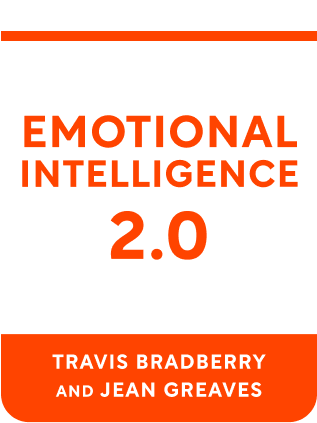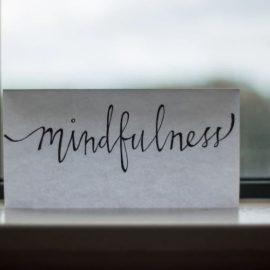

This article is an excerpt from the Shortform book guide to "Emotional Intelligence 2.0" by Travis Bradberry and Jean Greaves. Shortform has the world's best summaries and analyses of books you should be reading.
Like this article? Sign up for a free trial here .
What is emotional self-awareness? What can you do to bring your deep-seated emotions to the surface of your awareness?
Emotional self-awareness is the ability to identify and understand both your moment-to-moment emotions as well as the tendencies that build up over time. Emotional self-awareness is the first pillar of the emotional intelligence (EQ) construct.
Keep reading for more about emotional self-awareness.
What Is Emotional Self-Awareness?
Emotional self-awareness is defined as your ability to identify your emotions as they occur and recognize your tendencies during different scenarios.
People with high levels of emotional self-awareness:
- Recognize the people or situations that upset them
- Notice patterns of behavior in specific situations
- For example, they may recognize that they get angry when someone wastes their time or nervous when a particular person enters the room.
- Embrace emotional outbursts as learning opportunities
- Take time to decipher the reasons behind their emotional responses
- Know what they do well, and what they don’t
- Understand the things that motivate them
Why You Need It
| When Emotional Self-Awareness is Present | When Emotional Self-Awareness is Absent | |
| Perspective | You put your emotions into perspective, leading to increased satisfaction. | Without perspective, emotions get overwhelming, leading to high levels of stress and frustration. |
| Collaboration | You recognize when your emotions are impacting your work and that of the people around you and adjust accordingly. | You push your own emotions onto other people, causing higher levels of tension and stress amongst your team as a whole. |
| Decision-Making | You make well-thought-out choices because emotions don’t cloud your judgement. | You make poor decisions as triggers lead to reactive choices. |
15 Tactics to Develop Emotional Self-Awareness
Tactic #1: Understand the physical effects of your emotions. Close your eyes and examine different physical factors such as your heartbeat, breath, and muscle tension. Then, recall a memory that elicits a strong emotional response. Notice the way your body changes (you may notice that excitement causes your stomach to tighten, anger leads you to clench your jaw, or fear makes your legs shake). Recognizing physical responses allows you to quickly identify your emotions in your day-to-day life.
Tactic #2: Recognize your emotions in art. If you struggle to identify emotional tendencies, look to music, books, and movies to find material that you connect to. People resonate with material that reflects their emotional state. Sometimes, it’s challenging to put your emotions into words, and exploring art may help you communicate feelings that you previously were unable to express. Find a specific moment in your favorite movie, TV show, or book and observe the emotions and behaviors of the character in that moment. Then, ask yourself:
- Have I ever felt this way?
- Why do these emotions resonate with me?
- Do I recognize any of these behaviors in myself?
Tactic #3: Notice how you behave when stressed. Use that information to determine when you need to recharge. For example, during stressful situations, you may get knots in your stomach. This is a message from your body telling you to take a moment to relax. If you ignore the physical signs of stress, they could get worse, resulting in a headache or ulcer.
Tactic #4: Find the reason behind your emotion. Emotions act as a guide, pointing out things in your psyche or surroundings that you may not recognize otherwise. Assess why you’re feeling what you’re feeling. This helps you resolve any problems or tensions that are causing unwanted feelings. Questions to ask yourself include:
- When was the last time I felt this emotion?
- Does a specific person or scenario trigger this emotion?
- How did I react to this emotion in the past?
Tactic #5: Don’t identify your emotions as “good” or “bad.” Emotions aren’t “good” or “bad.” Judging a feeling only puts more emotions (such as shame or pride) on top of that feeling. This keeps your original emotion from developing and muddies your current emotional state. When you feel an emotional reaction coming to the surface, identify it and reserve judgement. This lets the emotion to arise and fade away without further complication.
For example, you’re frustrated with an assignment at work and immediately label that emotion as bad. This introduces new negative emotions into the mix. You may feel guilty for having a “bad” emotion towards work that you enjoy. You may get angry that you’re allowing yourself to get frustrated. Rather than just letting the frustration emerge and move on, you’re complicating your situation and lengthening the amount of time that it will take for your emotions to settle.
Tactic #6: Don’t let a “bad mood” dictate your behavior or decisions. If you allow your mood to cloud your perspective, you can lose control of your emotions and spiral quickly. When a bad mood arises, remind yourself that this mood is temporary. If you allow your bad mood to run its course, it will pass eventually. When in a bad mood, try not to make important decisions as your emotional state will likely influence your decision-making process.
Tactic #7: Don’t let a “good mood” dictate your behavior or decisions. Good moods can corrupt your perspective just as much as bad moods. Good moods create rose-colored glasses that prevent you from objectively assessing decisions and may lead you to rush into things without thinking them through.
For instance, your favorite online retailer is running a 50% off sale. You excitedly add things to your cart and click the order button without thinking about it. However, once you look at your bank account and realize that you should not have spent that money on online purchases, reality comes crashing back in.
Tactic #8: Know your triggers. Everyone has people and behaviors that push their buttons. Knowing what sparks an emotional response from you allows you to strategize for those situations. Be specific when noting your triggers. Identify people, activities, and environments that irk you. Then, mentally prepare yourself for those situations.
To take this to the next level, begin to explore the roots of your frustration. This helps you control your reactions when emotions arise. Ask yourself:
- What is it about these individuals or behaviors that frustrates me?
- Are there commonalities between these individuals or behaviors?
- Can I connect my frustration to something in my past?
For example, you have a co-worker who tries to make a joke of everything in a meeting. If you’re the type who wants to stay professional and focused in the workplace, this may annoy or frustrate you. If you haven’t prepared yourself for the situation, you may allow your emotions to get the best of you and snap at your colleague.
Tactic #9: Keep a journal of your triggers and emotions. Write down triggers as you discover them. Then, write down what emotional responses these types of situations create. This allows you to look back at past events and recognize patterns.These patterns help you develop a clearer sense of what elicits a strong emotional response from you and how you can better handle your triggers in the future.
Tactic #10: Be specific about the message you send to the world. The clothes you wear, your physical demeanor, and your facial expressions all send specific messages and usually reflect your internal emotions. These messages determine how colleagues (particularly acquaintances) will interact with you. Ask yourself:
- Did I actively choose to look this way?
- Does this look reflect what I’m feeling?
- Do I lean towards this look by default?
> For example, if you go to work wearing dirty clothes and unkempt hair, people may assume that you don’t take your job seriously. Similarly, if you don’t talk to anyone in your office throughout the workday, people may assume that you don’t want to be there.
Tactic #11: Acknowledge the “ripple effect” of your emotions. Your behavior affects everyone around you, even the people you don’t intend to influence. You can use your emotions as tools for growth or weapons for destruction. Observe how your behavior affects everyone around you and use those observations to guide your behavior.
For instance, you’re a manager at a restaurant. A waitress drops a glass, even though you just spoke to your team about being more careful. You scream at her in front of the wait staff, thinking that you’re making an example of her. While you may think that you’ve developed a sense of caution around carrying glassware, you may have also inadvertently created communal fear throughout your team that leads to drops in morale and productivity.
Tactic #12: View situations and your behavior objectively. Objectivity allows you to view a situation without the lens of emotion and determine the best way to ensure a positive result. Take time to step away from an emotional or heated situation and allow your feelings to settle. Once your feelings have subsided, take in all of the information surrounding the situation and make a decision based on logic.
For instance, you told your daughter to be home by 10. It’s now 11, and she still isn’t home. Your anger may begin to fester as you prepare to reprimand her for missing her curfew. Underneath your anger, however, is genuine concern. If you don’t take a moment to objectively think about the best route forward, you may go off on her, causing disdain and conflict. On the other hand, if you take a moment to survey the situation, you may build connection and empathy by leading with your concern for her, breaking down why you’re upset, and explaining the reasons behind your curfew rule.
Tactic #13: Respect your values. It’s easy to lose sight of your core values when life gets busy. If you allow emotions to overwhelm your beliefs in these moments, you’ll make decisions that don’t reflect the ideals you hold dear.
Think about your core values and state them explicitly. This will force you to solidify your central beliefs. Once you know your guiding principles, determine how you can make decisions that reflect these ideals. With enough practice, you’ll be able to hold yourself accountable and make value-driven decisions even when experiencing extreme emotions.
Tactic #14: Embrace discomfort. Avoiding painful feelings only creates a short-term solution and exacerbates problems further down the line. Instead of ignoring an emotion, dive into it and work through it. Embracing an uncomfortable emotion and understanding where it comes from allows you to identify negative behaviors and the reason behind your discomfort. Once you understand why you’re uncomfortable, you can handle the uncomfortable emotion more effectively.
For example, you feel unfulfilled in your career but don’t want to deal with that emotion, so you try to push your feelings away by relying on constant external validation to provide you with fulfillment. Though this validation may give you a temporary reprieve, it essentially puts a band-aid over a deeper emotional wound that you need to eventually deal with.
Tactic #15: Invite feedback. When it comes to examining your behavior, you’re inherently biased. You look at your choices and emotions through the lens of personal experiences, values, and tendencies. To develop a truly objective picture of yourself, reach out to other people to get an outside perspective on the ways you respond to certain situations or people.

———End of Preview———
Like what you just read? Read the rest of the world's best book summary and analysis of Travis Bradberry and Jean Greaves's "Emotional Intelligence 2.0" at Shortform .
Here's what you'll find in our full Emotional Intelligence 2.0 summary :
- What emotional intelligence is and why it's essential for your workplace success
- The 4 reasons you need to work on your EQ
- How you can use EQ to better manage relationships






